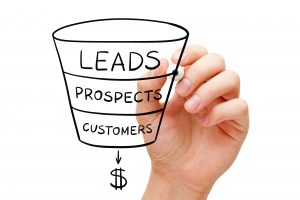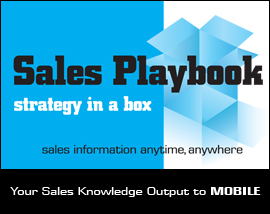Flipping The Sales Funnel

You may think the most important aspect of your sales force is your sales reps. Well, you’re wrong; it’s your customers. And the people who are really growing are the ones turning that traditional sales funnel on its side!
As a salesperson, you are used to seeing the world as a funnel. Your focus each day is to get more prospects in (via tactics such as cold calls) at the top and funnel them through, with hopes you will produce a warm lead. Sometimes funnels are leaky though, and you only get one or two commission opportunities. Another problem with the funnel in regards to growth is that the people you are trying to sell to have already bought from you. Salespeople are running out of new people to put at the top of the funnel, running out of people willing to take your call and listen to them; this is resulting in the warm leads drying up.
Now, back to the flipping of the funnel. By turning it on its side you create a “megaphone,” which you then give to the people who already love you – your regulars, your new customers, any people who you have previously sold to and who will say good things. Now that you have given these people the megaphone, watch the warm leads multiple! ** Warm leads are critical. As less and less cold calls are landing, it’s important to target those you’ve already gained permission from.
The megaphone lives largely online, within product review sites such as “Skiddoo” and in more traditional review sources such as Google or Facebook. These platforms are organized around the idea of a person telling a story about a salesperson, brand, product or service etc. If you show up in these places (in a positive context), people will find you.
So start targeting those warm leads, give them that megaphone along with incentives to provide to their social circle (i.e. coupons for a free visit), and direct them to those platforms. It’s less about landing a particular sale, and more about attracting new potential customers who will then spread the word about you even more!
read moreSales Processes & Why They Really Matter

Currently, the average sales organization is only closing about 49% of their sales. There are many reasons for this, some of which are organization specific, but two common reasons are:
- 40% of companies don’t have a clearly defined sales process. Without this, or mapped out steps and timelines, there is no way to accurately predict and manage your business.
- The forecasts, in many cases, are left up to the individual sales rep who are then required to provide their subjectivity on whether a sale will close or not. We recommend shifting more towards a behavioural based forecast, meaning you base the sale on the specific steps that must be taken to land it and less on the sales rep’s retelling of the events.
Another thing many sales organizations aren’t doing is seeing the significance in both the sales and buying behaviours; you must map these together when creating your processes. The buyer will have certain things they need validated along the way, and those should quickly become a part of your sales process. As you architect your sales process, you will begin to see how and why these two behaviours need to work together.
For salespeople wanting to improve we have three tips:
- Be one of the 60% of companies who have a clearly defined sales process.
- Understand where you are: What is your win rate, what is your average sales cycle, what is your average deal size? When you surface with these key questions, you can then determine the challenges and work with managers on solutions.
- You have to have a plan: Once you have your road map (sales process) defined you must figure out how to move along it. Whether that looks like bringing in sales consultants and account planners or implementing revised training, you need a clear path to solve the challenges that have been raised.
Sell Value, Not Price

Salespeople inherently want to sell value, and rarely intentionally sell on price. However, the problem is not based in intent, but lack of skills to actually sell value properly or to even know what value is (in relation to what they are selling). So, absent the right planning and skills, many sales people end up selling on price.
We like to look at value very simply: total benefit minus cost for the customer (value = total benefits – cost for the customer). During the sales process, you want to get as many benefits on your side of the equation as possible to avoid selling only on price. You need to quantify all of the benefits and be able to present them as a whole.
To lead customers into a value-focused conversation you must first start with research: what are the key business initiatives, who are the stakeholders, who are the users, who are the gatekeepers/influencers? As you map out the organization, you’ll quickly discover that the different constituencies have very different values and you begin think about the total benefit for the customer – not just one area.
Lots of salespeople find it difficult however to extract consideration of value from the gatekeeper’s/decision makers. You need good conversation skills, and must always remember to relate it back to their business’ initiatives. It’s also important to get them forward thinking, looking to the future, so they can envision the total cost of ownership. Lead these people in your direction by using/sharing the information you obtained from other stakeholders via research. Be sure your value proposition is fully organized and presentable when you get to this point, confirming and showing understanding of their company’s issues. If you don’t stay focused on these pieces, the customer may flip the conversation to price.
read moreStop Hiring Sales Candidates Who Fail to Deliver

It happens so often: you interview someone and you think they’re perfect for the role, only to have them disappoint on performance and under-deliver on results. So how do you spot a sales candidate with a high-achievement factor from all the schmoozers?
These two types of professionals can be easy to spot, if you know what you’re looking for. For example, candidates with a high-achievement factor will almost always bring a portfolio (or something similar) to the interview. They’re ready to show their achievements and discuss them in relation to your company. They also love answering difficult questions. Whereas candidates lacking the desire of high achievement would break out in sweat over senior/behavioral questions, “high and drive” candidates with the desire to succeed have a degree of comfort answering questions like this and see it as an opportunity where they can shine.
One common mistake we see often is that lots of companies are hiring based on a certain profile that matches their customer. This typically leads to them hiring candidates based on their industry knowledge and experience. This isn’t bad, but in our eyes, just isn’t enough. Candidates need to not only demonstrate understanding of the industry, but also need to showcase non-teachable, innate characteristics. This is the key to the process and the difference between hiring someone who knows how to sell versus someone who will actually sell.
Also, remember that depending on the type of sales (transnactional vs. relational), this process may look different. For example, companies with long sale cycles and continuous customer interaction have to make sure the candidates they’re hiring will work to deliver even on their darkest days.
read moreCompetition = Motivation

When it comes to sales teams businesses usually find their’s falling into one of two categories: companies who have their sales force strategy set, but whose adoption is mediocre or companies who claim that their sales force strategy adoption is ace but are missing critical components that could propel them further.
Whichever category you find yourself (or your business) falling under, it’s important to note that it all comes back to your team; the people doing your selling and making your money. As a business owner, manager etc. you have to oversee the sales team, ensuring there is trace of their activity. Once you garner the critical metrics and you monitor them for a period of time, you can more easily determine the important things going on in the company and how to properly motivate your team in that direction.
You’re probably thinking what is exactly meant by “critical metrics.” These can really be anything (i.e. if I can get to the first time or face-to-face meeting stage in the sales process then I know I can win opportunities more consistently), and once determined, should be closely measured/monitored as well as encouraged by those overseeing the team.
A method we find very effective to generating spikes in activity around critical metrics is creating social competition around them. Having your team socialize their performance (i.e. transparently discuss it to determine where team members are succeeding/failing), creates fire in those individuals who find themselves falling in the middle of the sales pact.
Using competition to motivate performance is definitely not a new tactic (hello, the classic leaders bored seen in so many sale environments), but with certain programs now available that automate things like leaderboards, now more than ever it’s easy to introduce competition. It’s also important to note that though reward/incentive is important, making it more about the actual competition has proven to be more effective when trying to motivate.
At the end of the day it is up to the sales managers to drive significant performance. They need to know their team’s strengths/weaknesses, determine those critical metrics and encourage those behaviours through tactics like competition. If you can successfully motivate spikes in those behaviours, spikes in sales should follow.


